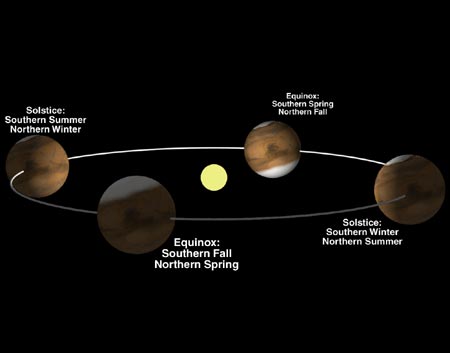Mars even has the same four seasons that we do but they just last much longer than ours

Mars: A Planet With Familiar Seasons, On a Different Scale

Mars, mankind’s neighboring planet, has always captivated our curiosity. As we explore and study this enigmatic celestial body, we continue to uncover fascinating similarities and differences between our two worlds. One intriguing fact is that Mars, like Earth, experiences four distinct seasons. However, unlike our comparatively brief seasons, Mars’ seasons are on an epic scale, lasting significantly longer.

The noticeable seasons on Mars are a result of its axial tilt, similar to Earth’s. While the Earth has a tilt of approximately 23.5 degrees, Mars displays a tilt of around 25.2 degrees. This tilt causes Mars to rely on its distance from the sun and the angle at which sunlight reaches different parts of the planet, resulting in varying temperatures and atmospheric conditions throughout the year.
Just as freezing winters and blooming springs define our seasons, Mars experiences similar changes, albeit on a grander scale. The Red Planet’s spring season sees the formation of exquisite clouds, consisting of carbon dioxide ice crystals suspended in the atmosphere. These formations create stunning patterns against the crimson backdrop, adding an ethereal beauty to the Martian landscape.
As spring transitions into summer on Mars, the planet undergoes dramatic transformations. The increased exposure to sunlight warms the surface, causing the polar ice caps to melt partially. The added moisture and abundance of sunlight create favorable conditions for dust storms to arise. These colossal storms, known as “haboobs,” can engulf entire regions, obscuring the planet’s surface and making it challenging for missions and rovers to explore.
During Mars’ extended summer season, which can last for six Earth months, the temperatures can soar above the freezing point, reaching up to a mild time of year on Earth. This warmth allows for increased evaporation, resulting in the formation of visible clouds, particularly near the equator. These wispy formations often appear as a thin veil, drifting across the Martian skyline, further enriching the planet’s mesmerizing ambiance.
As autumn approaches on Mars, the polar ice caps begin to reform. This process occurs due to the cooling temperatures, which cause carbon dioxide and water vapor to condense, forming ice crystals that reaccumulate. The changing atmospheric conditions may also trigger wind patterns, stirring up patterns of fine dust particles and creating impressive dust devils that dance across the Martian plains.
Finally, the onset of winter brings an icy chill to Mars, as temperatures plummet to their lowest points. The polar ice caps grow substantially, spanning vast areas and altering the planet’s appearance. It is during this frigid season that the carbon dioxide at the poles freezes, resulting in the formation of frosty landscapes that shimmer under the distant Martian sun.
Mars’ four elongated seasons exemplify the majesty and complexity of our neighboring planet. From vibrant spring clouds to scorching summer dust storms, and from delicate autumnal dust devils to serene wintery landscapes, Mars offers a captivating symphony of climate variations, shaped by its remarkable axial tilt.
As humanity continues to explore the mysteries of Mars, the knowledge we gain about these unique and lengthy seasons provides valuable insights into the intricate dynamics of planetary atmospheres. Excitingly, with each discovery, we inch closer to comprehending not only the Red Planet but also our own home, Earth, where smaller-scale seasons remind us of the wonders that exist both within and beyond our reach.
Sources:
Tags
Share
Related Posts
Quick Links
Legal Stuff

